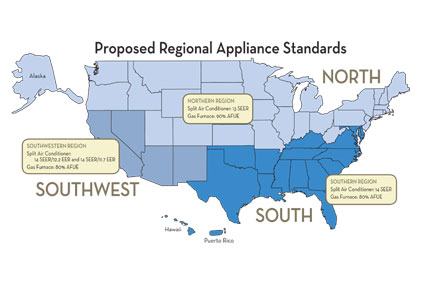American Public Gas Association (APGA) executive vice president Dave Schryver confirmed that the lawsuit, APGA v. U.S. Department of Energy (DOE), has entered mediation and that an agreement between the two parties could occur very soon.
“This is an extremely important issue to our members, which is why APGA brought suit this past May to challenge the furnace efficiency standards that DOE adopted in October 2011,” said Schryver. “It is APGA’s position that the furnace rule, in an attempt to increase efficiency, would inadvertently deter consumers from purchasing direct use natural gas appliances, which are more efficient than electric appliances.
“The appeal brought by APGA is in the mediation process, and that process has brought the parties sufficiently close to a settlement that DOE filed a consent motion with the D.C. Circuit [court] on November 13 requesting that the appeal be held in abeyance for 30 days in anticipation that the negotiations on settlement and implementation will be completed within that time frame.”
Jon Melchi, director of government affairs, Heating, Air-conditioning, and Refrigeration Distributors International (HARDI), said he is unable to reveal any of the settlement’s details under a gag order; however, he did say the recent court filing indicates a settlement could be close.
“We should know by Dec. 12 if we have an agreement or if the case resumes its path through the court system,” he said. “There are a lot of parties involved in these talks and coming to a solution which placates everyone is challenging.”
Regional Regulations
The DOE’s regional efficiency standards were adopted Oct. 25, 2011. The standards will essentially divide the country into three regions — North, Southeast, and Southwest — and the minimum efficiency standards for each equipment type will vary by the region in which it is installed. In the North region, most furnaces will be required to have an AFUE of 90 percent or more. In the Southeast and Southwest, central air conditioners will be required to have a SEER of 14. Heat pump and oil furnace standards will rise on a nationwide basis.
The idea was originally proposed in a comprehensive energy bill passed in 2007, the Energy Independence and Security Act (EISA). The act granted the DOE authority to create separate standards for HVAC equipment based on geographic region.
DOE crafted the regulation, released it for comment on June 27, 2011, and implemented it into law Oct. 25, 2011.
APGA Lawsuit
APGA filed an appeal of the DOE rule establishing regional efficiency furnace standards in the U.S. court of Appeals for the D.C. Circuit on Dec. 23, 2011. APGA opposed the rule and the process by which DOE enacted it.
APGA argued that DOE erred in using the direct final rule process in the context of this case (versus a normal notice and comment rulemaking), in issuing a rule that bans the non-condensing furnace in the northern region, and in adopting a new standard that will cause fuel switching, which is without economic justification.
In challenging the rule, APGA is asking the court to vacate the rule and remand it for a clean round of notice-and-comment rulemaking.
HARDI and Air Conditioning Contractors of America (ACCA) filed petitions to intervene through the U.S. Court of Appeals on behalf of the APGA based on the claim that the DOE failed to follow proper procedures in issuing the rules for regional efficiency.
Air-Conditioning, Heating & Refrigeration Institute (AHRI), the City of New York, and several environmental advocacy groups have sided with the DOE on the lawsuit.
Unanswered Questions
While it appears a settlement is on the horizon, details have not been released, leading to a mix of speculation as to what the final may include. Will the entire regulation be scrapped? Will the furnace portion be reconfigured, as the APGA’s chief interest lies in the gas-portion of the rule? Will all parts be re-examined through a revamped notice and comment period?
One thing is for sure, up until the mediation was announced yesterday, the industry has essentially been left in the dark.
Questions regarding enforcement, a potential installation waiver, a manufacturer-proposed 18-month extension, and concerns regarding a consensus agreement remain largely unanswered.
“I am concerned about the ramifications of rulings made, or to be made, by DOE regarding regional standards, specifically as it applies to HVAC equipment,” said Tim Kavanaugh, president of Indianapolis-based distributor, Federated Supply. “There are several slower-moving furnaces and heat pump units that I need to order now, so that I may be able to keep the right inventory levels for our dealer’s sales efforts; however, I am afraid of what may happen to them once we reach the May 1, 2013 deadline.”
Contractor Walter M. Reckinger III, Reckinger Heating and Cooling, Dearborn, Mich. shared his dismay on ACCA’s Hot Air! Blog.
“Installing a high-efficiency unit should be a customer’s choice. It should not be a government mandate,” he said. “We are trying to warn our customers of the impending deadline while they can still choose. If they can’t afford the change now because of the horrible economic environment, how will they be able to afford the higher cost equipment later?”
In October, a roomful of HARDI distributors unanimously endorsed the efforts of the organization in regards to the lawsuit.
“When the audience was polled about the future of the lawsuit, the group was unanimous and directed the leadership team to continue to do everything possible to protect and advance the interest of HARDI distributors,” said 2013 president-elect Brian Cobble, G.W. Berkheimer Co., Portage, Ind.
Melchi is quick to remind the industry that while the sides are negotiating, neither party has signed a formal agreement.
“There is still a lot of uncertainty out there and it is our hope that this will end favorably for us and the industry,” he said. “However, until a settlement or verdict is reached, the May 2013 implementation date is still a reality.”
Publication date: 11/19/2012



Report Abusive Comment